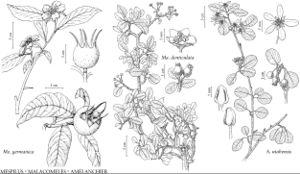Mespilus
Sp. Pl. 1: 478. 1753.
Gen. Pl. ed. 5, 214. 1754.
| Taxon | Illustrator ⠉ | |
|---|---|---|
 | Mespilus germanica Malacomeles denticulata Amelanchier utahensis | Barbara Alongi Marjorie C. Leggitt Marjorie C. Leggitt |
Shrubs or trees, 40–70 dm. Stems 1–few, ± erect; bark grayish, smooth, with numerous small horizontal lenticels, older rough, dark gray-brown; short-shoots absent or present; armed or unarmed, compound thorns on trunk absent; extending twigs canescent. Leaves deciduous, cauline, simple; stipules caducous, free, ± elliptic, herbaceous, margins entire or lobed, asymmetric, ± pilose; petiole present; blade narrowly oblong or narrowly elliptic to oblanceolate, rarely oblong-ovate, 5–12 cm, thin, margins flat, entire or finely serrate distally, venation camptodromous, surfaces ± pubescent. Inflorescences terminal on leafy short-shoots, these terminal on woody short-shoots or arising directly from extension shoots, 1 (or 2) -flowered, axes canescent; bracts present; bracteoles present, caducous or persistent, ± linear, 5–15 mm, membranous to coriaceous, abaxially ± hairy, eglandular. Pedicels present, short. Flowers: perianth and androecium epigynous, 25–35 mm diam.; hypanthium ± obconic, constricted apically, size not recorded, externally canescent; sepals 5, spreading, triangular; petals 5, white, usually suborbiculate, base barely clawed, apex ± notched; stamens 25–35 (–40), shorter than petals; carpels 5, connate, adnate to hypanthium, styles 5, subterminal, distinct; ovules 2, superposed. Fruits pomes, brownish, turbinate to subspheric, 15–40 mm diam. (larger in some cultivars), rough, punctate, glabrous or pubescent; hypanthium persistent; sepals persistent, erect to ± connivent, bases not touching; carpels woody; styles ± persistent, emerging through disc. Pyrenes 5, sides plane, covered by disc. x = 17.
Distribution
Introduced; Wash., Eurasia
Discussion
Species 1.
The Eurasian Mespilus germanica is a minor fruit, occasionally cultivated and naturalized in North America. Mespilus is retained here in the traditional concept of M. germanica, because it is distinct on a variety of characteristics and has a sister position to Crataegus (C. S. Campbell et al. 2007; E. Y. Y. Lo et al. 2007; D. Potter et al. 2007; Li Q. Y. et al. 2012; Lo and M. J. Donoghue 2012). Reproductive woody short shoots with close internodes, normal in Crataegus, occur frequently, though not universally; in the latter case, the inflorescence is borne on an annual short shoot lateral to or terminal on an extension shoot. Other notable characteristics of Mespilus that distinguish it from Crataegus include brownish fruit indicating mammal dispersal (C. M. Herrera 1989); large, hairy, eglandular bracteoles; extremely wide hypanthial opening in fruit; pyrenes covered by tissue of disc; and erect to connivent foliaceous fruiting sepals with bases distinct. Mespilus characters rarely seen in Crataegus are uniflorous inflorescences (found in C. uniflora); inflorescences borne on annual short shoots as noted above, very large flowers and stamens 25–35 (found in C. triflora).
The triploid ×Crataemespilus canescens (J. B. Phipps) J. B. Phipps (Mespilus canescens J. B. Phipps), is a plant with great horticultural potential. It is a large bush with numerous fasciculate stems; exfoliating bark; simple, nearly entire leaves; 2–6-flowered, semipendant, usually racemose, inflorescences that are commonly borne on short shoots of the season lateral to an extension shoot; flowers very like M. germanica in size and general appearance, but with fewer stamens; small bright red, hawthornlike fruit; large, abaxially hairy bracteoles with scattered very large marginal glands. A substantial colony has existed at one site in Arkansas.
Selected References
None.
Lower Taxa
"thin" is not a number.